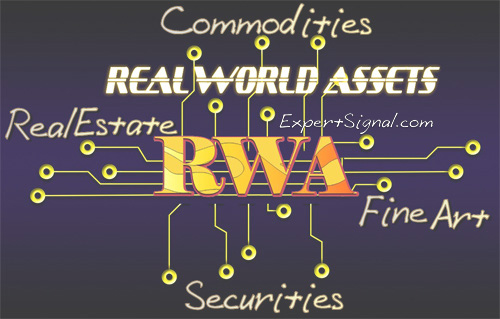Tokenized Real-World Assets (RWA): Transforming the Economy

Tokenized real-world assets (RWA) are digital representations of tangible assets—such as real estate, commodities, artwork, or securities—that are recorded and transferred via blockchain technology. Each token reflects ownership rights to a real asset, enabling easy and secure transfer, fractional ownership, and broader market accessibility.
As the concept gains traction, tokenizing the global economy is becoming an increasingly attractive idea, especially for institutional investors. The potential benefits—ranging from operational efficiency to increased liquidity—are too compelling to ignore.
Exploring RWA Tokens: A New Era of Ownership
One of the most significant innovations of RWA tokens is their ability to replace traditional ownership certificates with digital tokens. These tokens are governed by smart contracts, which automate legal and administrative processes, reducing the need for intermediaries like lawyers or notaries.
This shift can dramatically cut transaction costs and time for both buyers and sellers, particularly in high-value markets like real estate or fine art. With tokenization, ownership becomes more secure, transparent, and accessible, opening up new avenues for investment and liquidity in traditionally illiquid asset classes.
Pros and Cons of Tokenized Real-World Assets (RWA)
As tokenization technology matures, early RWA projects are primarily focused on decentralized finance (DeFi) and real estate. However, the broader application of RWA across the global economy is increasingly realistic. According to industry estimates, by 2030 there will be 29 billion connected IoT devices globally—offering a vast digital infrastructure for tokenization and real-world data integration.
Advantages of RWA Tokenization
-
Broad Asset Compatibility
Enables the tokenization of a wide range of assets—real estate, commodities, securities, fine art, hardware, and more.
-
24/7 Trading & Enhanced Liquidity
Blockchain allows for around-the-clock trading, increasing market liquidity and enabling real-time settlement.
-
Reduced Intermediary Costs
Smart contracts can automate legal, brokerage, and administrative functions, reducing or eliminating fees for middlemen like brokers and lawyers.
-
Privacy through Zero-Knowledge Proofs
Protocols using ZK-proofs can protect user identities while verifying ownership and transactions securely.
-
Global Accessibility
Opens up global markets—especially for users in developing countries who lack access to traditional financial systems.
-
Fractional Ownership
Makes high-value assets (like real estate or blue-chip art) affordable for small-scale investors by dividing ownership into smaller, tradeable fractions.
Disadvantages of RWA Tokenization
-
Issuer Risk
Investors are exposed to potential fraud or unfair practices from token issuers, especially in jurisdictions with weak legal oversight.
-
Smart Contract Vulnerabilities
Poorly coded smart contracts can be exploited by hackers—past RWA and DeFi projects have suffered significant losses from such exploits.
-
Regulatory Fragmentation
Compliance with varying legal frameworks across different countries is a significant hurdle. A globally aligned regulatory approach is still lacking.
Major RWA Projects
According to DefiLlama, there are currently 33 active RWA projects with a total value locked (TVL) of approximately $5.8 billion USD. Most of these protocols focus on the tokenization of financial instruments.
(a) Financial Instruments
Here’s a snapshot of MakerDAO's leadership in the Real-World Asset (RWA) tokenization space, along with some notable smaller projects worth watching:
Some projects to watch (listed on exchanges):
-
MakerDao.com (leading RWA, with $2.79b locked)
-
Maple.finance (institutional capital marketplace focusing on lending)
Others:
-
MatrixDock.com (short-term treasury bill token)
-
HashNote.com (US yield coin)
-
Backed.fi (US treasuries)
-
Actionariat.com (digital tools for creating a market for shares)
(b) Real Estate
Some projects to watch (listed on exchanges):
-
Propy.com (24/7 real-estate closings)
-
Lofty.ai (invest in rental properties without getting locked in/out)
Others:
-
Realt.co (real estate investing)
(c) Art and collectibles
The initial wave of blockchain tokenization was heavily focused on digital-native assets, especially digital art and collectibles, through Non-Fungible Tokens (NFTs). These NFTs represent unique, indivisible ownership of a digital file (like art, music, or in-game items). However, the scope has expanded significantly.
Some projects to watch (listed on exchanges):
Others:
How the Tokenization Process Works
Tokenization is the transformation of real-world assets (RWAs) into digital tokens on a blockchain. These tokens represent ownership rights and can be traded, stored, and verified using a secure, immutable ledger.
Step-by-Step: Tokenizing Physical Assets
1. Create a Special Purpose Vehicle (SPV)
A Special Purpose Vehicle is a legal entity that isolates financial and legal risk. It manages the asset pool, ensures compliance, and issues tokens to investors.
2. Asset Identification and Categorization
Define and classify the physical assets to be tokenized (e.g., real estate, art, commodities, or securities).
3. Valuation and Fractionalization
Calculate the asset’s total market value, then divide it into a set number of token units (e.g., 1,000 tokens for a $1 million property = $1,000 per token).
4. Select a Blockchain Platform
Choose a suitable blockchain (e.g., Ethereum, Polygon, Solana). Most tokenized assets use the ERC-20 or ERC-721 (NFT) token standards.
5. Develop Smart Contracts
Create programmable contracts that govern:
-
Ownership rights
-
Token transfers
-
Dividend or yield payments
-
Compliance rules (e.g., KYC/AML)
6. Token Generation
Mint the digital tokens using the smart contract. Each token represents fractional or full ownership of the real-world asset.
7. Custody and Safeguarding
Designate a regulated custodian to store or manage the underlying physical assets (e.g., a secure vault for gold, or property management for real estate).
8. Token Distribution
Offer tokens to investors via:
-
Security Token Offerings (STOs)
-
Centralized crypto exchanges (CEXs)
-
Decentralized exchanges (DEXs)
Compliance with local securities laws is critical during issuance.
What is an SPV (Special Purpose Vehicle)?
An SPV is a separate legal entity set up to isolate financial risk and manage a specific asset or project. In tokenization:
-
It pools investor capital
-
Issues tokens on behalf of investors
-
Ensures clear separation between asset liabilities and the parent organization
Final Thoughts on RWA Tokenization
Tokenization can revolutionize industries by:
-
Increasing access to high-value assets
-
Enhancing market liquidity
-
Reducing transaction costs
-
Enabling global 24/7 trading
However, physical asset tokenization still faces challenges:
-
Custodial trust (centralized governance must be transparent)
-
Legal clarity (cross-border compliance is still evolving)
-
Security (smart contract and platform-level risks)
A global regulatory framework for digital ownership could standardize practices and protect both issuers and investors, fueling broader adoption of RWA tokenization.
□ G. Protonotarios for ExpertSignal.com (December, 5th 2023)
Sources:
-
RWA Categories: https://defillama.com/categories
-
Connected Devices: https://explodingtopics.com/blog/number-of-iot-devices
MORE on ExpertSignal
■ COMPARE
► Crypto Accounts
■ LEARNING
» Cryptocurrency NFTs Guide
» RWA -Real World Asset Tokens
■ BITCOIN
» Bitcoin FAQ
■ EXCHANGES
► PrimeXBT
► ByBIT
► BitMex
► Gate IO





